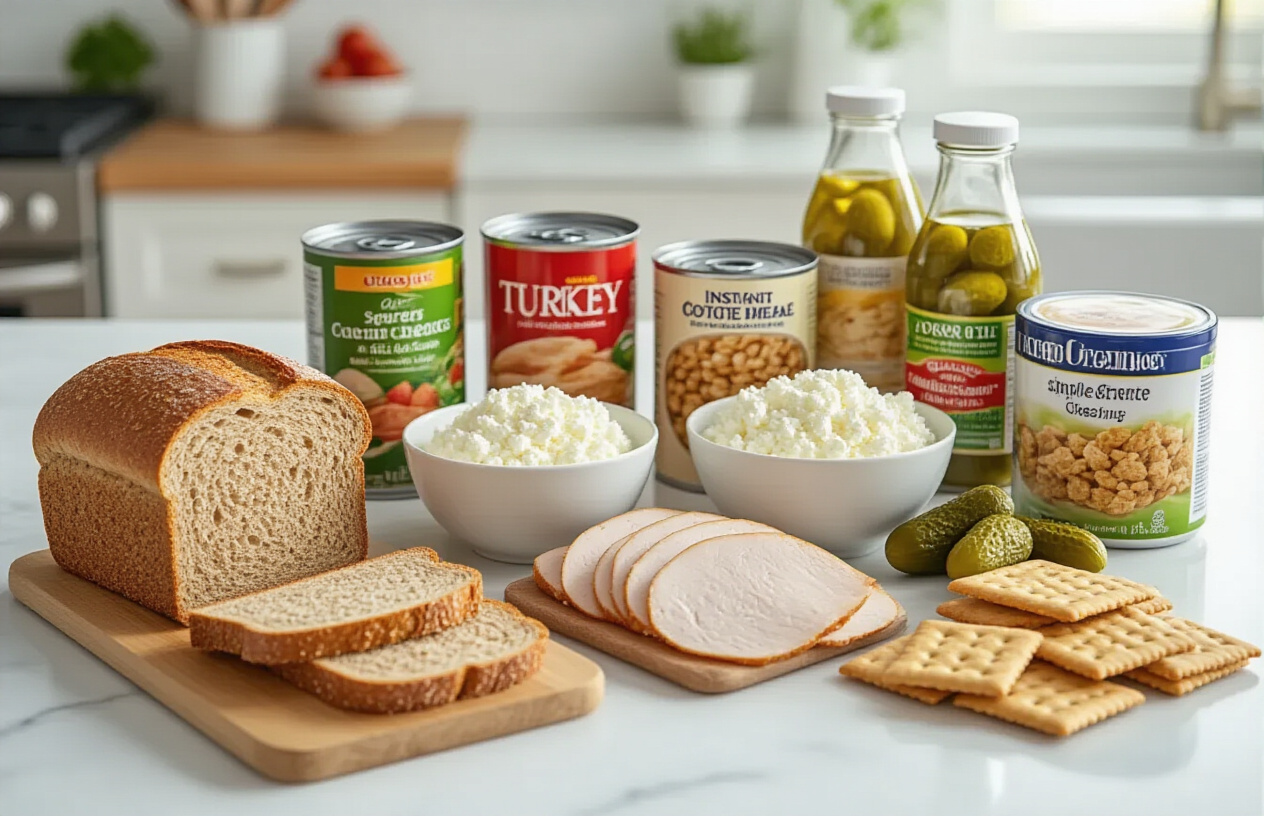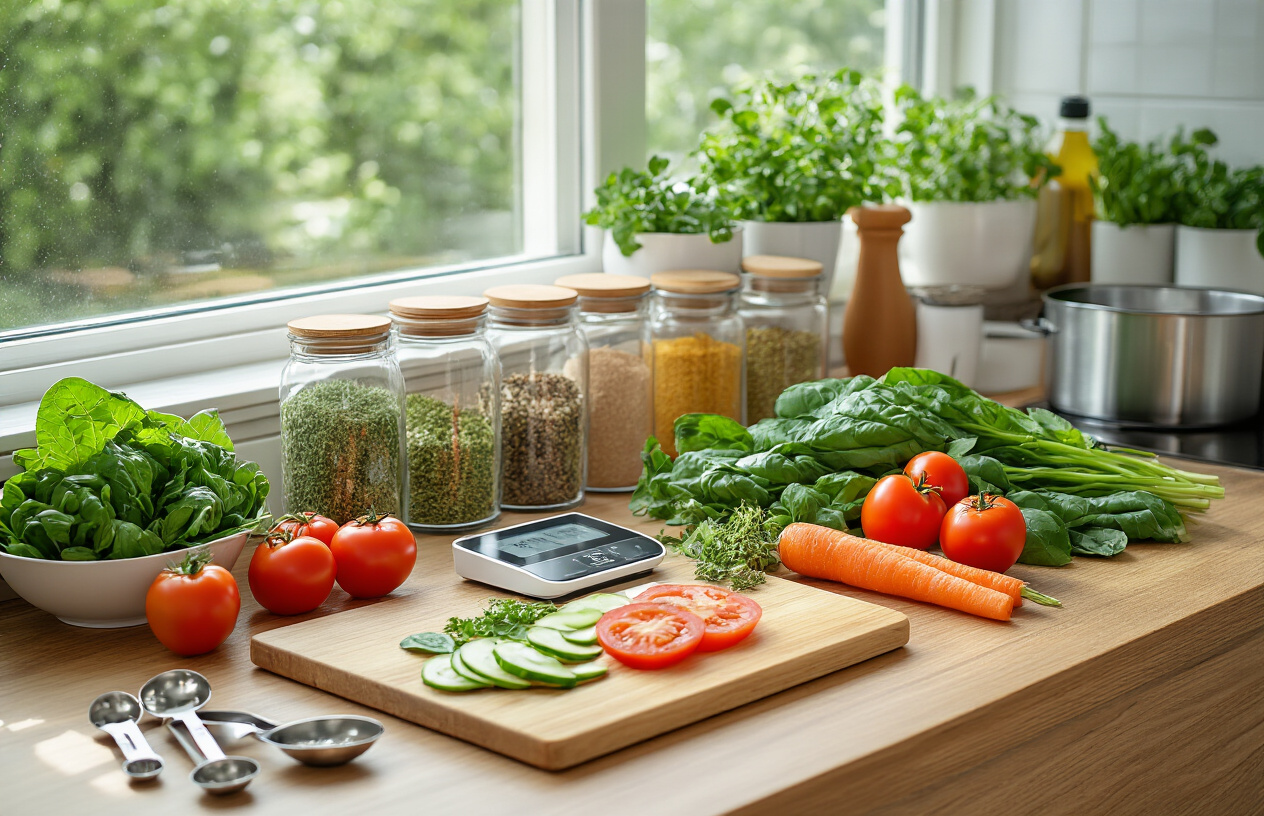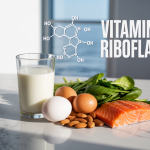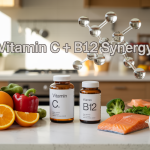Many people don’t realize that high-sodium foods are quietly damaging their health every single day. This guide is for anyone who wants to take control of their blood pressure, reduce bloating, and protect their heart from the hidden dangers lurking in everyday meals.
You might think you’re eating healthy, but sodium hides in places you’d never expect. We’ll expose the sneaky processed foods that pack more salt than a bag of chips, reveal which restaurant dishes contain a full day’s worth of sodium in one sitting, and uncover seemingly healthy options that are actually sodium bombs in disguise.
By the end of this article, you’ll know exactly which foods to avoid and have practical strategies to cut your sodium intake without sacrificing flavor.
Understanding Sodium’s Hidden Impact on Your Body

How Excess Sodium Raises Blood Pressure Dangerously
Your blood vessels act like a complex highway system, and sodium plays the role of traffic controller. When you consume too much sodium, your body holds onto extra water to dilute it. This additional fluid increases the volume of blood flowing through your arteries, creating pressure against vessel walls.
Think of it like turning up the water pressure in your garden hose. The increased force strains your arterial walls, making your heart work harder to pump blood throughout your body. Over time, this constant pressure damages delicate blood vessel linings and forces your cardiovascular system into overdrive.
The scary part? Most people don’t realize their blood pressure is climbing until it reaches dangerous levels. Your kidneys, which normally regulate sodium balance, become overwhelmed and can’t filter out excess sodium fast enough. This creates a vicious cycle where more sodium leads to more fluid retention, which leads to higher blood pressure.
The Link Between High Sodium and Heart Disease Risk
Chronic high sodium intake sets off a domino effect that dramatically increases your risk of heart disease. When your blood pressure stays elevated for months or years, your heart muscle thickens to cope with the extra workload. This condition, called left ventricular hypertrophy, reduces your heart’s efficiency and increases the risk of heart failure.
High sodium also promotes inflammation throughout your cardiovascular system. This inflammation damages artery walls, making them more susceptible to plaque buildup. The combination of high pressure and inflammatory damage creates the perfect storm for atherosclerosis, where fatty deposits narrow your arteries and restrict blood flow.
Research shows that people consuming more than 2,300mg of sodium daily face a 25% higher risk of heart disease compared to those who keep their intake under control. Even more alarming, those consuming over 4,000mg daily see their risk jump by nearly 50%.
Kidney Damage from Prolonged High Sodium Intake
Your kidneys bear the brunt of excessive sodium consumption, working overtime to maintain proper fluid balance. These bean-shaped organs contain millions of tiny filters called nephrons that process your blood and remove waste. When sodium levels spike, these filters face intense pressure that can cause permanent damage.
High sodium intake forces your kidneys to retain more water, increasing blood volume and putting strain on the entire filtration system. Over time, this leads to scarring of kidney tissue and reduced function. The damage often goes unnoticed because kidneys can lose up to 90% of their function before symptoms appear.
Prolonged high sodium consumption also increases your risk of kidney stones. Excess sodium causes your kidneys to excrete more calcium in urine, which can crystallize and form painful stones. Additionally, the constant high pressure from sodium-induced hypertension damages the small blood vessels in your kidneys, potentially leading to chronic kidney disease.
Bloating and Water Retention Effects You Feel Daily
The immediate effects of too much sodium show up in ways you can see and feel every day. Within hours of consuming a high-sodium meal, your body starts holding onto extra water to maintain proper sodium concentration in your blood.
This water retention manifests as:
- Facial puffiness, especially around your eyes when you wake up
- Swollen fingers and ankles that make rings tight and shoes uncomfortable
- Abdominal bloating that makes your clothes feel snug around your waist
- Weight fluctuations of 2-5 pounds from one day to the next
Your body’s sodium-sensing mechanisms trigger thirst, making you drink more fluids that your kidneys then struggle to process efficiently. This creates a cycle where you feel bloated, uncomfortable, and sluggish. Many people mistake this sodium-induced water retention for weight gain, not realizing that reducing sodium can provide almost immediate relief from these uncomfortable symptoms.
The bloating and puffiness you experience after a salty meal aren’t just cosmetic issues – they’re warning signs that your body is struggling to maintain proper fluid balance.
Sneaky Processed Foods Loaded with Sodium

Deli Meats and Cured Products Contain Shocking Amounts
Deli meats and cured products are among the worst sodium offenders hiding in plain sight at grocery stores. A typical 3-ounce serving of deli turkey contains around 900-1,200 mg of sodium – that’s already half your daily limit in just one sandwich portion. Ham hits even harder, packing up to 1,500 mg per serving.
The sodium comes from multiple sources: salt used for flavor, sodium nitrates for preservation, and various sodium-based compounds that extend shelf life. Processed meats like salami, pepperoni, and bologna can contain 1,200-1,800 mg of sodium per serving. Even “low-sodium” versions often contain 400-600 mg, which is still substantial.
Hot dogs deserve special mention – a single frankfurter delivers 500-700 mg of sodium. Bacon strips pack about 200 mg each, meaning a typical 3-strip breakfast serving adds 600 mg before you’ve even started your day.
Canned Soups Pack More Sodium Than You Realize
Canned soups masquerade as convenient, healthy meals while delivering astronomical sodium levels. A single cup of chicken noodle soup contains 850-1,200 mg of sodium, and most people eat the entire can, which doubles that amount. Campbell’s classic tomato soup delivers 1,110 mg per cup, while their chicken and rice soup contains 940 mg.
The sodium serves multiple purposes: preserving the soup, enhancing flavors, and maintaining texture during the canning process. Even “healthy” varieties can be problematic. Many organic and reduced-sodium options still contain 400-600 mg per serving.
Broth-based soups tend to be the worst offenders, with some varieties reaching 1,400 mg per cup. Cream-based soups aren’t much better, averaging 800-1,100 mg per serving.
Frozen Meals Hide Dangerous Sodium Levels
Frozen dinners and entrees are sodium bombs disguised as convenient meal solutions. A typical frozen dinner contains 1,000-2,300 mg of sodium – often exceeding your entire daily recommended intake in one meal. Popular brands like Stouffer’s, Lean Cuisine, and Healthy Choice regularly pack 800-1,500 mg per serving.
The high sodium levels come from preservatives, flavor enhancers, and the need to maintain taste after freezing and reheating. Pizza rolls contain about 300 mg per piece, and most people eat 6-8 pieces. Frozen burritos typically contain 800-1,200 mg each.
Even frozen vegetables aren’t safe – those with sauce packets can contain 400-800 mg of sodium per serving, turning healthy vegetables into high-sodium side dishes.
Cheese Products Add Unexpected Sodium to Your Diet
Cheese naturally contains some sodium, but processed cheese products take it to dangerous levels. American cheese slices contain 250-400 mg per slice, while string cheese averages 200 mg per stick. Cottage cheese, often considered healthy, packs 400-500 mg per half-cup serving.
Processed cheese spreads and cheese sauces are particularly problematic. Velveeta contains 410 mg per ounce, while Cheez Whiz delivers 440 mg. Even cream cheese contains 85-100 mg per tablespoon, adding up quickly in recipes or on bagels.
Aged cheeses like parmesan, blue cheese, and feta are naturally high in sodium due to the aging process. Parmesan contains 450 mg per ounce, while feta delivers 400 mg per ounce. These numbers add up fast when sprinkled on salads or pasta dishes.
Restaurant Foods That Destroy Your Sodium Goals

Fast food chains serve sodium bombs disguised as meals
Drive-through meals pack astronomical amounts of sodium into seemingly ordinary food items. A single McDonald’s Big Mac contains 1,010 mg of sodium, while their large fries add another 400 mg. That’s already 60% of your daily sodium limit in just one meal.
Subway’s footlong Italian BMT delivers a shocking 2,980 mg of sodium – nearly double the recommended daily intake. Even their “healthier” turkey breast sandwich contains over 1,000 mg. The problem isn’t just the meat; it’s the processed cheese, condiments, and sodium-preserved bread working together.
Taco Bell’s Crunchwrap Supreme seems innocent enough but contains 1,200 mg of sodium. Their seasoned beef, cheese sauce, and tortilla each contribute significant amounts. A typical fast-food breakfast sandwich can contain 1,500-2,000 mg of sodium before you’ve even started your day.
Chain restaurant entrees exceed daily limits in one dish
Casual dining restaurants often serve portions that would feed two people, but the sodium content can feed an entire family’s daily needs. Applebee’s Classic Buffalo Wings contain 4,700 mg of sodium – more than three times the daily recommendation. Their Bourbon Street Chicken and Shrimp delivers 3,840 mg.
The Cheesecake Factory takes sodium excess to new heights. Their Chicken Bellagio contains 2,530 mg of sodium, while their Louisiana Chicken Pasta reaches 2,370 mg. Even seemingly lighter options like their Chicken Caesar Salad pack 1,570 mg.
Olive Garden’s Tour of Italy plate delivers 3,350 mg of sodium in a single serving. Their breadsticks alone contribute 400 mg each, and most people eat several during their meal. Chain restaurants rely heavily on sodium for flavor enhancement and food preservation, creating dishes that taste great but wreak havoc on your cardiovascular system.
Bread and baked goods contribute hidden sodium overload
Restaurant bread baskets seem harmless, but they’re sodium landmines. Two dinner rolls at Red Lobster contain 580 mg of sodium. Panera’s French baguette slice has 310 mg, and their bagels range from 400-600 mg each.
Pizza crusts are particularly problematic. A large Pizza Hut pan pizza crust alone contains over 1,000 mg of sodium before any toppings. Domino’s medium hand-tossed crust adds 900 mg. The cheese, sauce, and processed meats multiply this number exponentially.
Restaurant muffins and pastries hide significant sodium amounts. Dunkin’s blueberry muffin contains 510 mg, while Starbucks’ lemon loaf has 350 mg. These baked goods use sodium for leavening, preservation, and flavor enhancement. When you factor in the sodium from butter, cream cheese, or jam, a simple breakfast pastry can easily exceed 800 mg of sodium.
Seemingly Healthy Foods with Dangerous Sodium Levels

Vegetable juices contain more sodium than soda
Many health-conscious people swap soda for vegetable juice, thinking they’re making a smart choice. The reality is far more shocking. A single cup of regular vegetable juice can pack 600-900mg of sodium – that’s nearly half your daily limit in one drink. Compare that to a can of Coca-Cola, which contains only 34mg of sodium.
Tomato juice leads the pack as one of the worst offenders, with some brands containing up to 1,000mg of sodium per cup. V8 Original vegetable juice delivers 640mg per serving, while many organic and “natural” varieties aren’t much better. Even low-sodium versions often contain 140-200mg per cup, which adds up quickly if you’re drinking multiple servings.
The sodium comes from added salt used for flavor enhancement and preservation. Without it, vegetable juices would taste bland and have shorter shelf lives. Manufacturers know that salt makes their products more palatable, so they use it liberally.
Cottage cheese and yogurt hide high sodium content
Cottage cheese appears on countless healthy eating lists, but it’s secretly loaded with sodium. A single cup of regular cottage cheese contains 700-900mg of sodium – more than a bag of potato chips. Even the “reduced sodium” varieties pack 400-500mg per cup.
Greek yogurt, another supposed health food, can be equally problematic. While plain varieties are relatively low in sodium, flavored versions and those with mix-ins can contain 100-200mg per serving. When you eat multiple servings daily, these numbers multiply quickly.
The sodium in these dairy products comes from the manufacturing process. Salt is added during production to enhance flavor, improve texture, and act as a preservative. Cheese-making requires salt for proper curd formation, which explains why cottage cheese is particularly high in sodium.
Breakfast cereals pack unexpected sodium punch
Your morning bowl of cereal might be sabotaging your sodium goals before your day even begins. Many popular cereals contain 200-400mg of sodium per serving, and that’s before adding milk. Cheerios contains 140mg per cup, while Raisin Bran delivers 210mg per cup.
“Healthy” cereals often contain even more sodium. Some bran cereals and whole grain options pack 300-400mg per serving. The sodium acts as a flavor enhancer and preservative, helping cereals maintain their taste and crunch longer.
The problem gets worse when you consider serving sizes. Most people pour significantly more cereal than the recommended serving size, easily doubling or tripling their sodium intake. Add salty toppings like nuts or cheese, and your breakfast becomes a sodium bomb.
Sports drinks deliver sodium you don’t need
Sports drinks market themselves as healthy hydration solutions, but they’re sodium delivery systems in disguise. A 20-ounce bottle of Gatorade contains 270mg of sodium, while Powerade packs 250mg per bottle. For most recreational exercisers, this sodium is completely unnecessary.
Unless you’re sweating heavily for more than an hour in extreme conditions, your body doesn’t need the extra sodium found in sports drinks. Regular water handles hydration needs perfectly for most workouts. The added sodium in sports drinks is designed for endurance athletes who lose significant amounts of salt through prolonged, intense sweating.
Many people drink sports drinks casually throughout the day, treating them like flavored water. This habit can add 500-1,000mg of unnecessary sodium to your daily intake, pushing you well over healthy limits.
Condiments and sauces multiply your sodium intake
Small portions of condiments and sauces can destroy your sodium budget in seconds. A single tablespoon of soy sauce contains 1,000mg of sodium – nearly half your daily limit. Teriyaki sauce isn’t much better at 600mg per tablespoon.
Common condiments pack surprising sodium punches:
| Condiment | Serving Size | Sodium Content |
|---|---|---|
| Soy sauce | 1 tablespoon | 1,000mg |
| Fish sauce | 1 teaspoon | 600mg |
| Worcestershire sauce | 1 tablespoon | 167mg |
| Ketchup | 1 tablespoon | 154mg |
| Barbecue sauce | 2 tablespoons | 300-500mg |
Salad dressings are equally problematic. Ranch dressing contains 135mg per tablespoon, while Italian dressing packs 243mg. Most people use 2-4 tablespoons on their salads, multiplying these numbers significantly.
The worst part? These condiments are designed to be used liberally. Restaurants and food manufacturers know that people don’t measure condiments carefully, so a “light drizzle” often becomes a sodium overload.
Smart Strategies to Slash Your Sodium Consumption

Reading nutrition labels saves you from sodium traps
The nutrition facts panel becomes your best friend when battling hidden sodium. Start by checking the milligrams of sodium per serving, keeping in mind that the American Heart Association recommends staying under 2,300mg daily, with 1,500mg being ideal. The % Daily Value column shows how much sodium each serving contributes to your daily limit – anything above 20% is considered high.
Watch out for serving size tricks. That innocent-looking can of soup might contain 2.5 servings, meaning you’ll multiply the sodium content by 2.5 if you eat the whole thing. Compare similar products side by side – you’ll be shocked at how sodium levels vary between brands. A simple switch from one brand of bread to another can save you 200mg of sodium per slice.
Look for sodium-related keywords in the ingredient list: salt, monosodium glutamate, sodium bicarbonate, sodium citrate, and sodium phosphate all add up. Ingredients appear in order of quantity, so if any sodium source appears in the first five ingredients, you’re dealing with a high-sodium product.
Fresh ingredients replace processed food dangers
Fresh foods naturally contain minimal sodium, making them your secret weapon against sodium overload. A fresh chicken breast contains about 70mg of sodium per 4-ounce serving, while processed deli turkey packs over 1,000mg in the same portion. Fresh vegetables, fruits, and unprocessed grains give you maximum nutrition without the sodium burden.
When shopping, stick to the perimeter of the grocery store where fresh produce, meat, and dairy live. The inner aisles house most processed foods loaded with sodium. Frozen vegetables without added sauces work just as well as fresh ones and often cost less. Just avoid those convenient frozen meals – they’re sodium bombs in disguise.
Meal prep becomes easier when you control every ingredient. Cook large batches of fresh proteins, grains, and vegetables on weekends. Store them in portion-sized containers for quick weekday meals. This approach costs less than buying processed alternatives and gives you complete control over your sodium intake.
Herbs and spices create flavor without sodium risks
Your spice rack holds the key to delicious, low-sodium cooking. Fresh herbs like basil, cilantro, and parsley add bright flavors that make you forget about salt. Dried spices such as cumin, paprika, and garlic powder create complex tastes without adding a single milligram of sodium.
Acidic ingredients like lemon juice, lime juice, and vinegar brighten flavors naturally. A splash of balsamic vinegar on roasted vegetables or a squeeze of lemon on grilled fish eliminates the need for salt. Hot sauce (check labels for low-sodium versions) and fresh chilies add heat and flavor complexity.
Create your own salt-free seasoning blends. Mix garlic powder, onion powder, dried herbs, and spices for an all-purpose seasoning. Keep different blends for different cuisines – Italian herbs with oregano and basil, Mexican blends with cumin and chili powder, or Asian-inspired mixes with ginger and sesame seeds. These homemade seasonings cost less than store-bought versions and contain no hidden sodium.
Experiment with umami-rich ingredients like mushrooms, tomatoes, and nutritional yeast. These foods provide the savory depth that salt usually offers, satisfying your taste buds while keeping sodium levels in check.

The hidden sodium in your favorite foods might be doing more damage than you realize. From that innocent-looking frozen dinner to your go-to restaurant meal, these sneaky sources can easily push your daily sodium intake way beyond healthy limits. Even foods that seem nutritious – like certain breads, cereals, and salad dressings – can pack a surprising sodium punch that sabotages your health goals.
Taking control of your sodium intake doesn’t mean giving up all the foods you love. Start reading those nutrition labels more carefully, cook more meals at home where you control the salt, and don’t be afraid to ask restaurants about lower-sodium options. Small changes like choosing fresh ingredients over processed ones and experimenting with herbs and spices can make a huge difference in how you feel and your long-term health.














